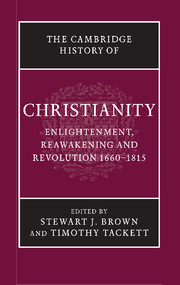Book contents
- Frontmatter
- Introduction
- PART I CHURCH, STATE, AND SOCIETY IN THE EUROPEAN WORLD, 1660–1780
- PART II CHRISTIAN LIFE IN THE EUROPEAN WORLD, 1660–1780
- 5 The Catholic clergy in Europe
- 6 The Protestant clergies in the European world
- 7 Reaching audiences: Sermons and oratory in Europe
- 8 Christian education
- 9 Christianity and gender
- 10 Popular religion
- 11 Jewish–Christian relations
- 12 Architecture and Christianity
- PART III MOVEMENTS AND CHALLENGES
- PART IV CHRISTIAN DEVELOPMENTS IN THE NON-EUROPEAN WORLD
- PART V REVOLUTION AND THE CHRISTIAN WORLD
- Chronology
- Bibliography
- Index
- References
5 - The Catholic clergy in Europe
from PART II - CHRISTIAN LIFE IN THE EUROPEAN WORLD, 1660–1780
Published online by Cambridge University Press: 28 March 2008
- Frontmatter
- Introduction
- PART I CHURCH, STATE, AND SOCIETY IN THE EUROPEAN WORLD, 1660–1780
- PART II CHRISTIAN LIFE IN THE EUROPEAN WORLD, 1660–1780
- 5 The Catholic clergy in Europe
- 6 The Protestant clergies in the European world
- 7 Reaching audiences: Sermons and oratory in Europe
- 8 Christian education
- 9 Christianity and gender
- 10 Popular religion
- 11 Jewish–Christian relations
- 12 Architecture and Christianity
- PART III MOVEMENTS AND CHALLENGES
- PART IV CHRISTIAN DEVELOPMENTS IN THE NON-EUROPEAN WORLD
- PART V REVOLUTION AND THE CHRISTIAN WORLD
- Chronology
- Bibliography
- Index
- References
Summary
This survey of the Catholic clergy in Europe, from 1650 to the eve of the French Revolution, will present a comparative outline of the various ecclesiastical groupings, divided into two main branches. The first of these, the secular clergy, consisted of the episcopal hierarchy and the lower clergy of parish priests, clerics belonging to the major orders, and the floating population of those who were in minor orders or merely tonsured. The regular clergy consisted of the male and female members of the monastic orders, the mendicant orders, and the regular congregations. If any conclusion may be drawn from these pages, it is that the different models and forms of Catholicism which developed in Europe between the Counter-Reformation and the Enlightenment, were all affected by the general trend towards uniformity and universalism directed by the Roman Church. But these new models were also influenced by both the ancient religious and political traditions which had permeated religious institutions and religious life for centuries, and by the specific political and social conditions which existed in different parts of Europe.
The Spanish and Portuguese bishops
Although they no longer possessed the religious and political status of the sixteenth-century episcopate, the Spanish bishops of the early seventeenth century continued to provide the principal model for the episcopal hierarchies of the whole of Europe. In the fifty-four Spanish dioceses, expanded to sixty in the eighteenth century, the bishops were all chosen by royal appointment. The majority had previously been canons of the cathedral chapters, and possessed university qualifications, most commonly degrees in canon and civil law.
- Type
- Chapter
- Information
- The Cambridge History of Christianity , pp. 87 - 108Publisher: Cambridge University PressPrint publication year: 2006

